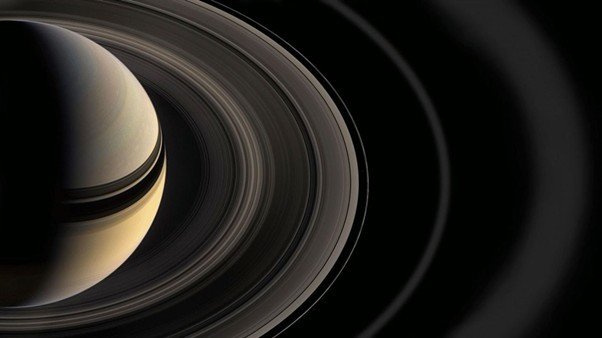Planet Saturn is a gas giant – the second largest planet in the Solar System, composed mainly of hydrogen and helium. It is the leader in the number of its moons, hosting as many as 146 in its orbit, whereas Jupiter has “only” 95. Yet the most remarkable feature of Saturn is its rings. They stretch over 280,000 kilometers in width but are only between 10 meters and 1 kilometer thick. Proportionally, the rings are as thin as a razor. We have known about them since 1610, when Galileo Galilei observed them. More than 400 years later, we have learned about their structure and possible origin, yet much remains unknown.
Origin of the Rings
It turns out that Saturn is not the only planet with rings – Jupiter, Neptune, and Uranus also have them. However, their rings are not as bright and extensive as Saturn’s, as they contain less water ice, which makes them harder to observe. This raises the question: why do all gas giants have rings?
The origin of the rings is not yet fully understood. To figure it out, it is important to determine how long these rings have existed. If they are young (approximately 100 to 400 million years old), it would imply that some relatively recent event created them. It is most likely that they formed from collisions among large moons. The moons would have broken apart into countless small fragments, but due to the planet’s strong gravity, these pieces would have remained orbiting it. However, if they are young, that also means they will eventually disappear. This suggests that the rings are not a stable structure, and we are fortunate to live in a time when we can marvel at them around Saturn.
There is also another possibility – that the rings formed 4.5 billion years ago, at the same time when Earth and the other planets were formed. This sounds like a plausible scenario, as the early days of the Solar System were chaotic – planets migrated from their original positions and there were many more collisions among planets and other cosmic objects. Consequently, there was a higher likelihood that one or several massive collisions occurred around Saturn, as well as near other gas giants, producing enough material to form rings. Currently, scientists actively debate both scenarios, although the first option – that the rings are young – is considered more likely.

Foto: Steven Hobbs, CICLOPS (Cassini Imaging), NAS
Ring Structure
Planetary rings are composed mostly of rocks, water ice, and dust. They range from microscopic dust particles to objects the size of a house. In Saturn’s case, they consist almost entirely of water ice.

Foto: MARK GARLICK / SCIENCE PHOTO LIBRARY
These rings have a specific structure and are divided into several groups – the most prominent of which are the A, B, and C rings. In these rings, density waves can be observed, which have formed due to gravitational interactions with Saturn’s nearby moons. In this case, the density waves are ring bands in which there are areas of higher and lower density. This also creates a wavy visual representation of these bands.
Gaps are also visible in the rings – voids between the rings. For example, the Encke Gap in the A ring is caused by the moon Pan, which orbits within it. It has cleared this band, either by expelling or gravitationally attracting the material present there.
Ring Lifespan
The lifespan of Saturn’s rings is also a topic of active discussion. Here, we must again return to their origins – were they formed essentially alongside Saturn itself, or much later? Assuming the latter scenario, their lifespan is likely not long – approximately 100 to 400 million years. At present, the water ice particles are held in balance between Saturn’s overwhelming gravitational force and their orbital speed, which tends to fling them into space. Meanwhile, sunlight can “charge” these particles, allowing the magnetic field to influence them. The charged particles then travel along the magnetic field lines toward Saturn’s surface, where they eventually vaporize. Thus, the rings lose part of their material.
This could also be one of the reasons why we do not observe prominent rings around Jupiter, Uranus, and Neptune. In this case, we haven’t been lucky – we live in an era when these planetary rings are at the end of their existence. Only after several million years might they be replenished by moon collisions or other events that would provide them with rings as prominent as Saturn’s.
How to Observe the Rings Yourself
Saturn and its rings are best observed when the planet is in opposition – that is, when it is directly opposite the Sun, closest to Earth, and visible throughout the night. During this period, Saturn is very bright, and its rings are easily visible even with small telescopes or good binoculars. To fully appreciate the beauty of its rings, it is recommended to use a telescope with a magnification of at least 50 to 100 times. Of course, it is best to make observations on clear, dark nights away from the light pollution of large cities.
In 2025, Saturn will be particularly well observable from August to October. With the aid of a telescope, one will be able to observe not only the rings but also Saturn’s largest moons, such as Titan—the only moon in the Solar System with a dense atmosphere—as well as Rhea, Dione, and other smaller moons.








